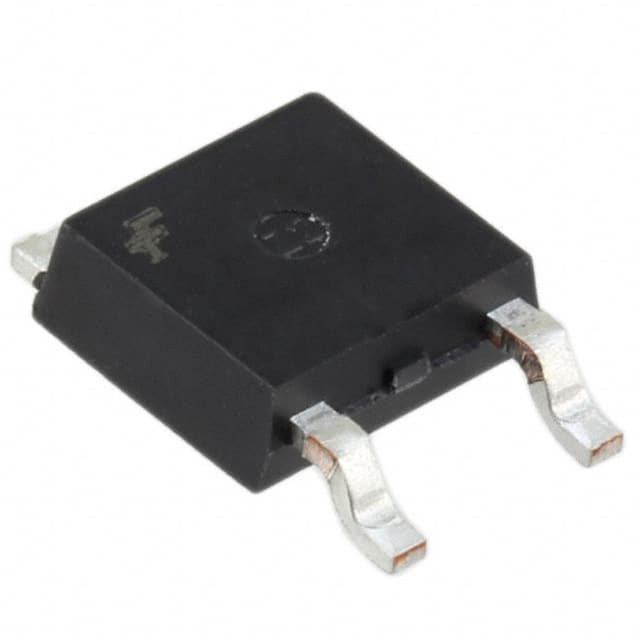FQD4N50TF
Introduction
The FQD4N50TF is a power MOSFET belonging to the category of electronic components used in various applications. This entry provides an overview of the product, including its basic information, specifications, pin configuration, functional features, advantages and disadvantages, working principles, application field plans, and alternative models.
Basic Information Overview
- Category: Electronic Components
- Use: Power MOSFET for electronic circuits
- Characteristics: High power handling capacity, low on-resistance, fast switching speed
- Package: TO-252 (DPAK)
- Essence: Efficient power management
- Packaging/Quantity: Typically available in reels or tubes containing multiple units
Specifications
- Voltage Rating: 500V
- Current Rating: 4A
- On-Resistance: 1.6Ω
- Gate Charge: 12nC
- Operating Temperature Range: -55°C to 150°C
Detailed Pin Configuration
The FQD4N50TF typically follows the standard pin configuration for a TO-252 package: 1. Source (S) 2. Gate (G) 3. Drain (D)
Functional Features
- High voltage capability
- Low gate charge
- Fast switching speed
- Low on-resistance
Advantages and Disadvantages
Advantages
- Efficient power management
- Suitable for high voltage applications
- Fast switching speed for improved performance
Disadvantages
- Higher cost compared to lower voltage MOSFETs
- May require additional heat dissipation measures for high-power applications
Working Principles
The FQD4N50TF operates based on the principle of field-effect transistors, where the voltage applied to the gate terminal controls the flow of current between the source and drain terminals. By modulating the gate voltage, the MOSFET can efficiently regulate power flow within electronic circuits.
Detailed Application Field Plans
The FQD4N50TF finds extensive use in various applications, including: - Switching power supplies - Motor control circuits - Inverters and converters - Electronic ballasts - LED lighting systems
Detailed and Complete Alternative Models
Some alternative models to the FQD4N50TF include: - IRF840 - STP4NK60ZFP - FQP4N40 - IPP60R190E6
In conclusion, the FQD4N50TF power MOSFET offers high voltage capability, low on-resistance, and fast switching speed, making it suitable for diverse electronic applications requiring efficient power management. Its specifications, pin configuration, functional features, and application field plans provide valuable insights for engineers and designers seeking to incorporate this component into their designs. Additionally, awareness of alternative models allows for flexibility in component selection based on specific project requirements.
Senaraikan 10 soalan dan jawapan biasa yang berkaitan dengan aplikasi FQD4N50TF dalam penyelesaian teknikal
What is FQD4N50TF?
- FQD4N50TF is a MOSFET (Metal-Oxide-Semiconductor Field-Effect Transistor) used in various technical solutions for power management and switching applications.
What are the key specifications of FQD4N50TF?
- The FQD4N50TF typically has a voltage rating of 500V, a current rating of 4A, and low on-resistance for efficient power handling.
In what technical solutions can FQD4N50TF be used?
- FQD4N50TF can be used in applications such as power supplies, motor control, lighting, and other high-voltage switching circuits.
What are the advantages of using FQD4N50TF in technical solutions?
- FQD4N50TF offers low on-resistance, high voltage capability, and fast switching characteristics, making it suitable for high-power applications.
How does FQD4N50TF compare to other MOSFETs in its class?
- Compared to other MOSFETs, FQD4N50TF offers a good balance of voltage, current, and on-resistance, making it suitable for a wide range of applications.
Are there any specific considerations for using FQD4N50TF in circuit design?
- Designers should consider the voltage, current, and thermal requirements of their application to ensure proper operation and reliability when using FQD4N50TF.
Can FQD4N50TF be used in high-frequency switching applications?
- While FQD4N50TF can handle moderate switching frequencies, it may not be suitable for very high-frequency applications due to its inherent capacitance and switching losses.
What are the typical thermal considerations when using FQD4N50TF?
- Proper heat sinking and thermal management are important when using FQD4N50TF to ensure that it operates within its temperature limits for long-term reliability.
Are there any common failure modes associated with FQD4N50TF?
- Common failure modes include overvoltage stress, overcurrent conditions, and excessive junction temperatures, which can lead to device degradation or failure.
Where can I find detailed application notes and reference designs for using FQD4N50TF in technical solutions?
- Manufacturers' datasheets, application notes, and online resources provide detailed information and reference designs for incorporating FQD4N50TF into various technical solutions.


